
Michigan is a beautiful state known for its wonderful residents, both human and animal alike.
This great area is home to a wide variety of different animals in the area, most of which are fairly resilient to the cold given the state’s northern climate.
Michigan is known for having a humid continental climate with very cold winters and very warm summers.
Its dramatically different seasons make it an ideal location for plenty of different kinds of wildlife, including owls.
Want to learn more? This National Geographic Book on Owls is a great read!
Currently, Michigan is home to a total of eleven different kinds of owls, some of which are permanent residents while others are only seasonal visitors.
Much like other states, Michigan is home to a variety of natural elements and exciting outdoor features.
This particular state plays home to a variety of different natural spaces including state parks and lakes, making it ideal for spending a little time out in nature to look for some owls.
The trees that are commonly found in the state parks are an excellent environment for many different kinds of owls, which is why so many people are partial to spending time camping out in this region.
Want to attract Owls to your yard? Take a look at our article!
What Owls can be seen in Michigan?
Table of Contents
1. Barn Owl (Rare)
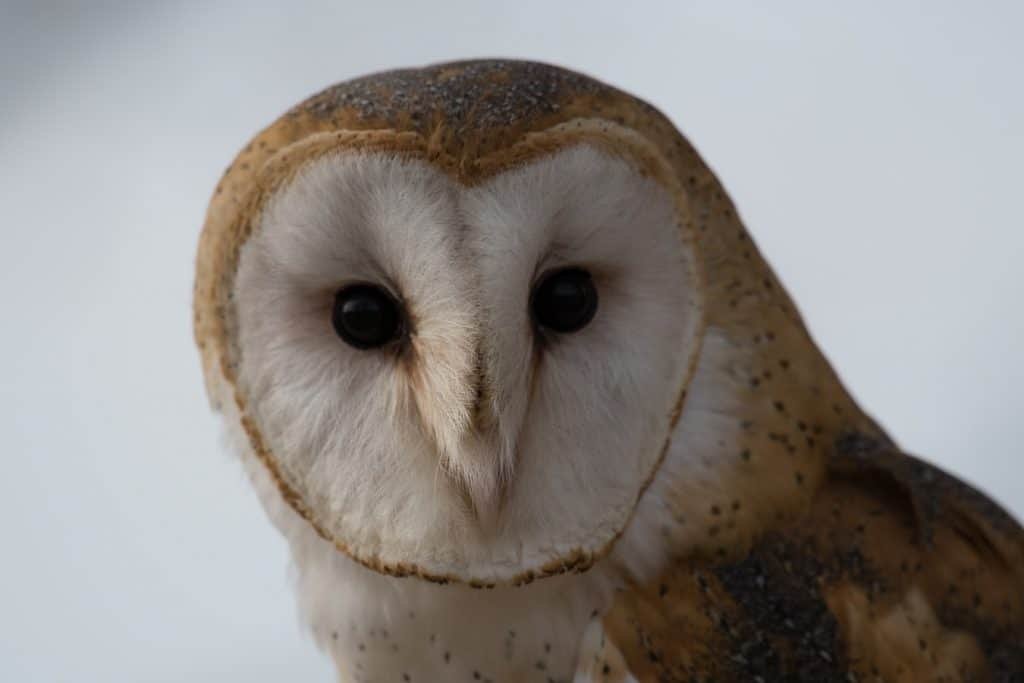
Wingspan
107 to 110 cm
Weight
430 – 620 g
Life Expectancy
Up to 4 years
Diet
Voles, Shrews & Mice
The Barn Owl is a beautiful bird known for its unique tendency to nest in covered areas like barns.
These birds are partial to their fair share of abandoned buildings and are most commonly known by their white heart-shaped faces that stand out in the night time.
These beautiful white-faced birds are completely nocturnal so it is more likely that you will see them at night.
Though you might find the Barn Owl perched in a tree during the day, your chances of spotting them are much better when the night sky has darkened.
It is generally around this time that you will see them leaving their nests to hunt.
As their name would imply, Barn Owls prefer plenty of cover.
This is why they are known to make nests in covered areas around Michigan, including old buildings, underneath platforms and bridges, and the underside of the occasional cliff.
These birds are considered to be threatened in Michigan, but your chances of seeing them are still fairly good.
2. Eastern Screech Owl
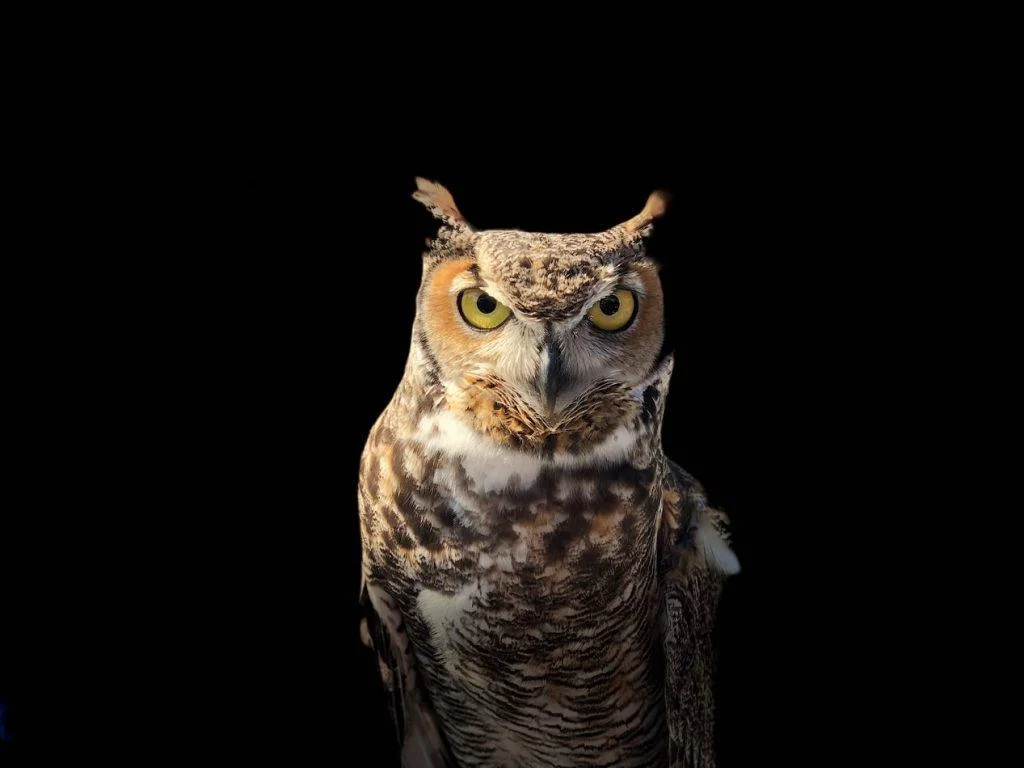
Wingspan
46 to 61 cm
Weight
160 g
Life Expectancy
14 years
Diet
Rats, Squirrels, Rabbits & Skunks
The Eastern Screech Owl is a small yet powerful bird known for its unique call.
The Eastern Screech Owl is most commonly heard when it is descending in the night sky during a hunt or when it is calling out for a mate.
The end result is a sinking sound that makes it easy to know when they are in the area.
They are known to spend their days snoozing and their nights hunting and these adorable owls are just as happy among the trees as they are in the air.
This funny little owl is known for staying put. Unlike other owls, Eastern Screech Owls have a tendency to stay in place year-round.
This means that your chances of spotting one are actually fairly good if you are lucky. The Eastern Screech Owl breeds in Spring for Michigan and is known for increased activity at this time.
These smaller owls are active at night, so try to keep an eye out around dusk and the early hours of the night.
The Eastern Screech Owl is no stranger in Michigan and is known for frequenting heavily populated areas. Since it is a smaller owl, it blends in well among other birds.
However, these elusive birds are more commonly heard than seen. If you are lucky, you might see one performing its unique mating dance which involves quite a bit of bowing to woo a lucky girl.
Look for them in suburban areas and even city parks. When you hear their call, act quickly to catch a glimpse of these feathered friends!
3. Great Horned Owl
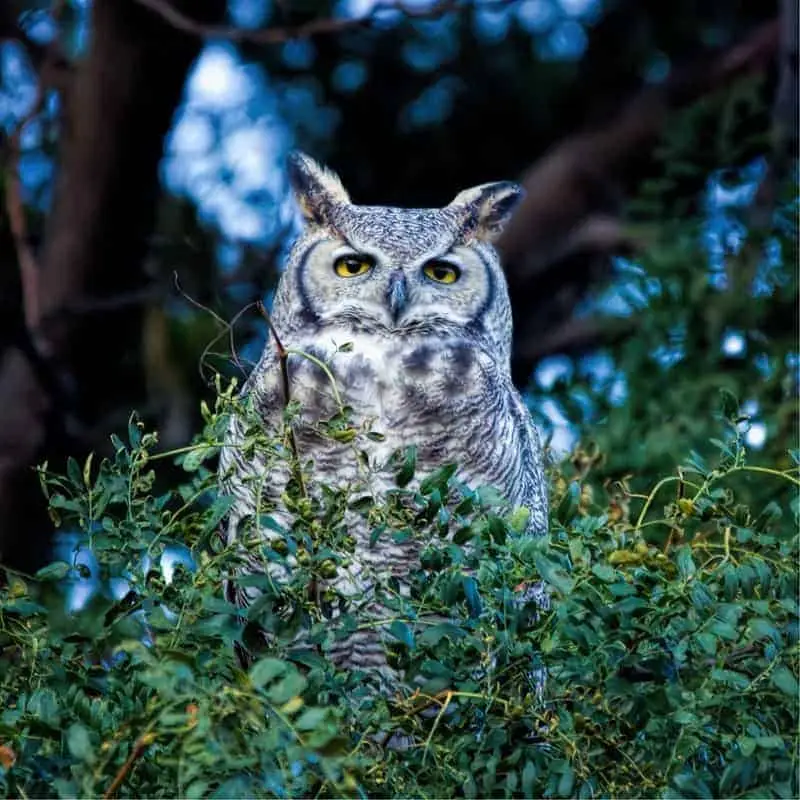
Wingspan
~140cm
Weight
1.4 kg
Life Expectancy
28 years old
Diet
Squirrels, Rabbits & Skunks
The Great Horned Owl gets a pretty bad reputation because of its intimidating appearance.
Though some owls are known for being soft and adorable, the Great Horned Owl has a large size and stark silhouette that stands out among other owls.
Its uniquely curved feathers make it an easy to spot bird, but it does have a slightly demonic appearance that some people just don’t like. Its grey and brown form is easy to spot because of its substantial wingspan.
When it comes to spotting the Great Horned Owl, you are probably in luck as long as you are an early bird.
The Great Horned Owl has been known to happily grace an area with its presence first thing in the morning and can be spotted in highly populated places.
You might just be lucky enough to spot this gigantic bird after it has caught a nice snack. At night, these active birds can generally be found by their deep voices.
Despite its larger than average size, this is one owl that can be spotted just about anywhere in Michigan.
It is a carefree bird that is happy to go where it pleases as long as there is enough room to move around.
Many people have spotted sightings in the Rose City birdwatching community, but these birds are spread far and wide.
4. Barred Owl
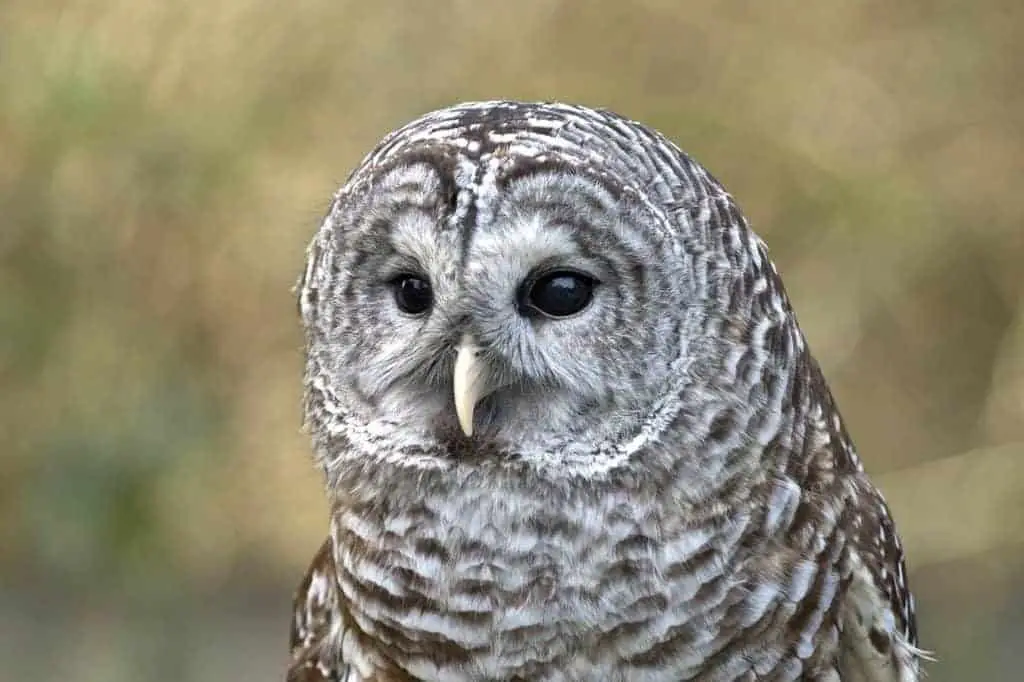
Wingspan
107 and 111 cm
Weight
720 g
Life Expectancy
23 years
Diet
Birds, Fish, Reptiles
The Barred Owl is happiest among the trees because that is where it prefers to nest.
It is known for spending its days roosting and has a wonderful little call that is more commonly heard during the mating season.
Out of all of the owls, these ones are particularly picturesque with their unique brown feathers and pleasant demeanour.
The Barred Owl is happiest at night time, which means your chances of seeing it after dark are fairly substantial.
You can expect to see these wonderful birds spreading their wings and flying during the hunt after the darkness has taken over.
They tend to mate in Spring in Michigan, so you can expect to see more activity around this time.
Lake Michigan is known for its serene beauty and also for its Barred Owls.
These birds are known to spend time in mostly wooded areas, so natural regions are naturally more appealing to them.
Their nests are often tucked away inside trees and they tend to hunt in forests.
As long as you have some time after dark to seek out their beautiful forms, you can generally see them on a good camping trip.
5. Northern Saw-whet Owl
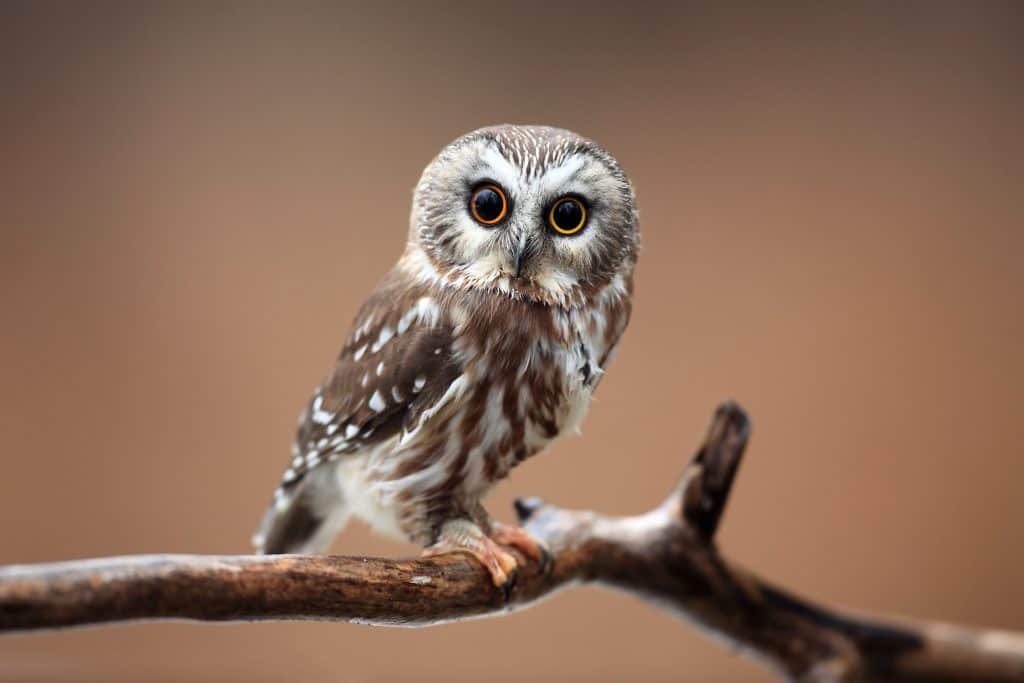
Wingspan
40 - 60 cm
Weight
100 g
Life Expectancy
7 years
Diet
Small birds, young squirrels, voles & shrews
Some owls are simply known for being nothing short of adorable. These tiny owls are some of the cuter ones around because everything about them is made to make them appear small and precious.
They have no notable ear tufts, tiny round heads, and a cute little body that makes them look like more of a cartoon owl than anything.
For this reason and more, many people find them to be exceptionally cute.
When it comes to spotting these unique owls, you have to focus on nighttime activity. They are most commonly found flying around at night hunting for prey.
Cute as they may be, they are quite adept at hunting and can be seen flying between trees as they seek out something delicious to eat.
Seeing the Northern Saw-Whet Owl is incredibly possible in Michigan because these birds are known to prefer spending time up north.
Predominantly found in Alaska and Canada, Michigan is a good place to spot them because of its proximity to the more focused areas.
When it comes to casually hanging out, these birds can be found in forests, particularly when there is dense brush in the area.
It is more likely that you will see them while camping or on a night hike.
6. Short-Eared Owl
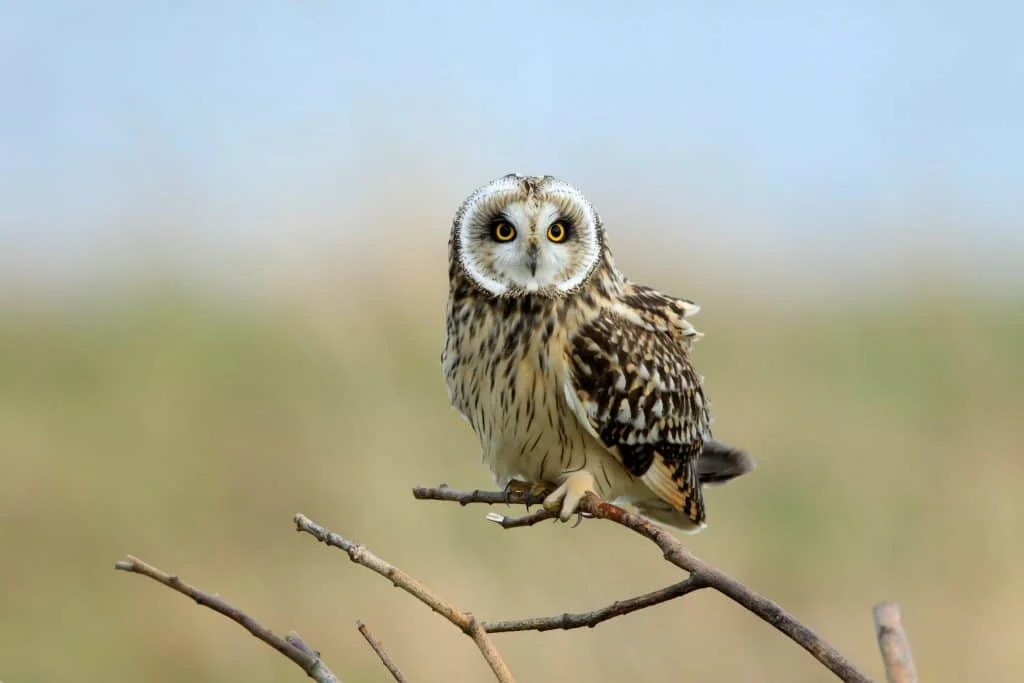
Wingspan
85 to 110 cm
Weight
206–475 g
Life Expectancy
4-12 years
Diet
Voles, Mice, Squirrels
The Short Eared Owl is a bird that is known for its soft and round appearance.
Though many owls have prominent ears, these owls have tiny curved ears that are virtually non-existent compared to others.
Their hearing works just as well, but you simply can’t see their ears unless you get incredibly close. They are also most commonly recognized for their short tails and beautiful brown feathers.
Though the majority of the United States only gets to see these birds prominently in Winter, the Short-Eared Owl finds Michigan to be far north enough to warrant some attention.
You can recognize these birds at dusk because of their unusual flight patterns.
If you happen to spot a bird that looks like it is flying a bit batty as the sun sets low in the sky, you might have witnessed your very own Short Eared Owl!
The last area of prominence that the Short Eared Owl was spotted in Michigan was in Saginaw.
These birds are not known for their high numbers, so witnessing them is generally a treat.
However, you are more likely to see them close to the ground than you are to see them in the air.
When they hunt, they hunt close to the ground, barely moving above the vegetation as they scan for delicious prey to feast upon.
7. Snowy Owl
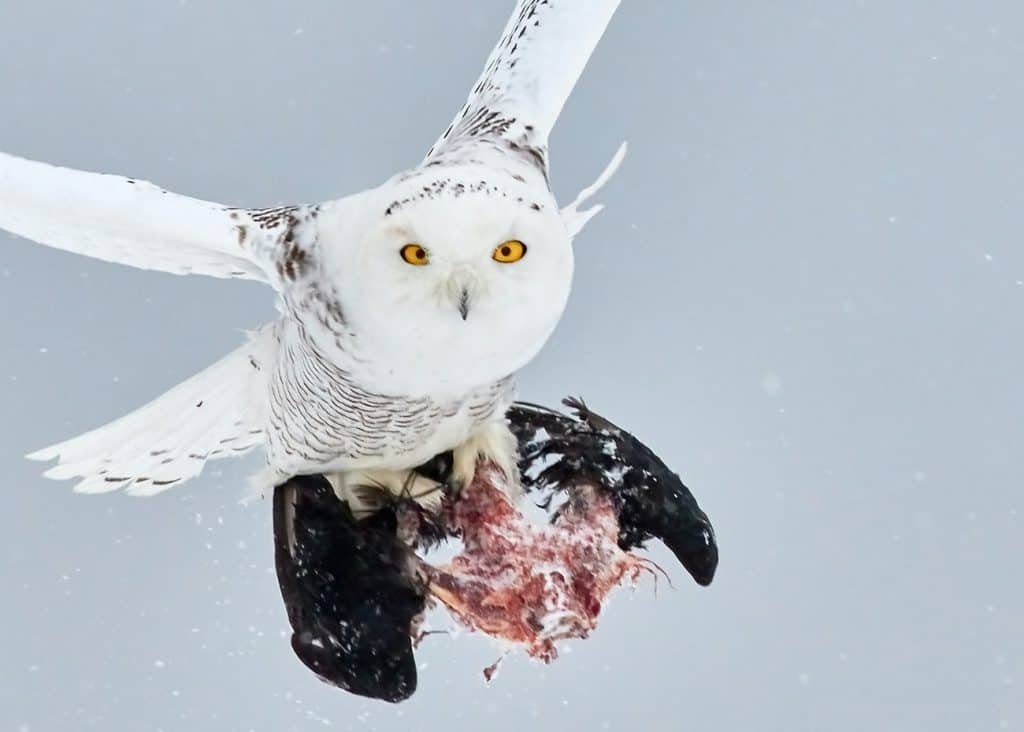
Wingspan
150 cm
Weight
2 kg
Life Expectancy
10 years
Diet
Birds, Rabbits, Fish & Rodents
The Snowy Owl is a beautiful bird that will leave you wondering if you have witnessed a miracle of nature when it flies by.
These birds are known for pristine white feathers that make them blend in perfectly with a snowy background.
They are a migratory and monogamous species that is known to spend as much time on the ground as in the air.
If you are lucky to see one of these beautiful birds, it will leave you talking about it for ages. Their yellow eyes make it possible to spot them in a snowy backdrop!
Unlike most other owls, the Snowy Owl is a bird that is perfectly happy flying out and about throughout the day.
Since they hunt both during the day and at night, the good news is that your chances are much higher when it comes to seeing them.
These migratory birds have been known to travel south in winter and that is when you will see them.
Most of the year these unique birds can be found in Alaska and Canada, but they have been known to grace the Northern states when it gets a little too cold.
Fortunately, Michigan is the perfect place to see them, and their numbers are going up year over year.
The Snowy Owl is known for being fairly open about its territory.
As long as you have some nice open space, chances are that the Snowy Owl can find a way to enjoy itself.
They are known for nesting on the ground, so you might see them perched on the ground as they look for a delicious snack.
These beautiful white birds are happy hunting a variety of creatures. Looking for areas with rabbits and rodents, like fields, might just increase your chances.
8. Long Eared Owl
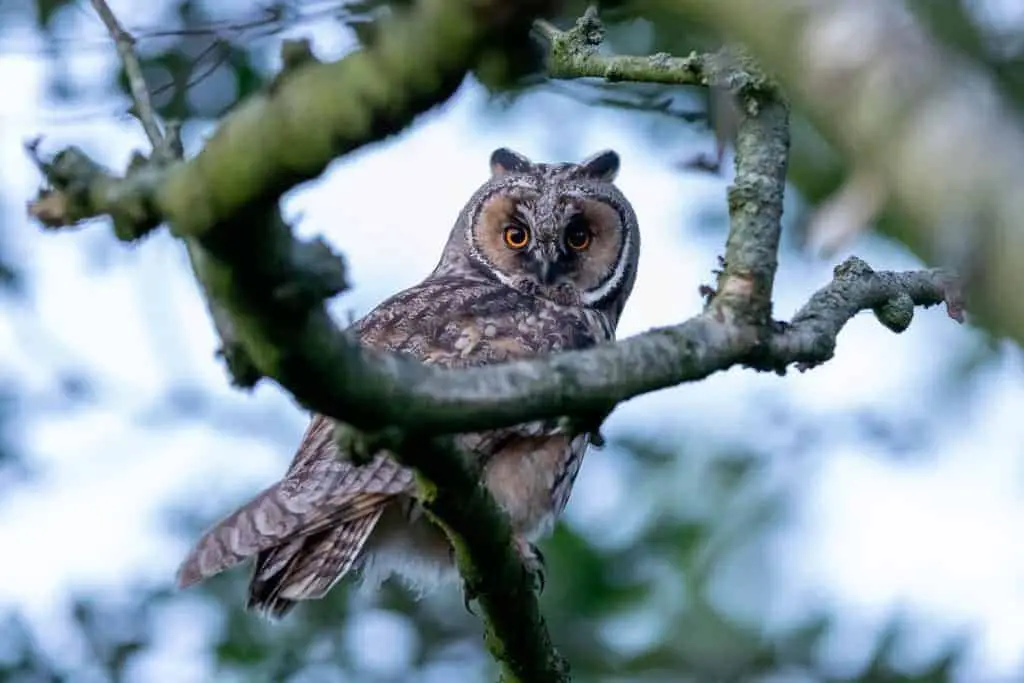
Wingspan
90 to 100cm
Weight
250 g
Life Expectancy
4 years
Diet
Small mammals, mice, rats & rabbits
The Long Eared Owl is a big bully and thief depending on who you ask.
These birds are most commonly known for their large size that makes them exceptionally intimidating, particularly if you are a small woodland creature.
Though you might consider them to be a protector of an area, the fact is that these birds knowingly use their large size to chase off other birds and take over their nests.
In fact, the Long Eared Owl seldom makes a nest of its own, instead preferring to steal the nest of another bird and add a little extra to it in the process.
It is often easier to see owls during mating season, which is in Winter in Michigan. Sometimes the season can also run fairly late into the following Spring.
It is a known way to spot them, as they are generally more active during this time. For many people, this is a great way to catch a glimpse of them.
Whether you have another bird nest nearby or you know for a fact that an owl can be found there, any nest just might lead you to a Long Eared Owl.
These birds are nocturnal, so try taking a peek around after dark.
The Long Eared Owl can be found all around Michigan, but some counties, like Bay County, have shown more activity than others.
These large birds prefer forests and are most at home in conifer trees.
When you seek them out, you will have to venture out into nature to see them. They can be most commonly found in areas with a lot of plant life.
9. Northern Hawk Owl (Rare)
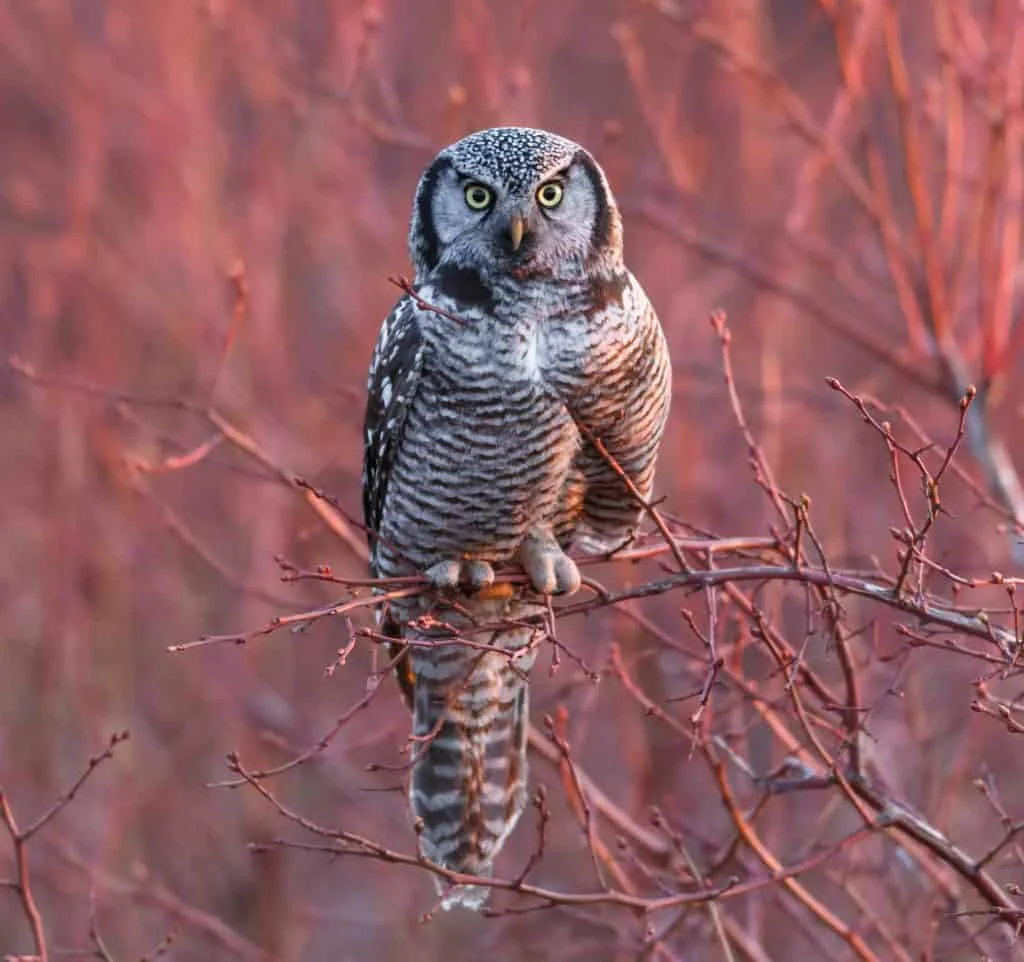
Wingspan
45 cm
Weight
300 -340 g
Life Expectancy
Up to 16 years
Diet
Rodents & Small Mammals
Much like its name implies, the Northern Hawk Owl has a distinct hawk look to its appearance.
Though it has the general body shape of an owl, it is most commonly known for its unique hawk-like face and color scheme, making it look like an oversized cousin to some of the other hawks in the area.
Despite their brown feathers and white speckling, they are very much owls and are known for their unique interest in taking over old nests.
Unlike some owls that will force other animals out, these owls are more likely to move into older bird nests that have long since been abandoned.
Seeing the Northern Hawk Owl is easier than trying to spot some of the other owls around.
Though the majority of owls are nocturnal, the Northern Hawk Owl Prefers to spend its time exploring areas during the day.
Just like the hawk, this bird is happy to spend plenty of time soaring in broad daylight while it looks for food.
This is probably another reason that people sometimes mistake them for plump little hawks since the birds are generally found flying around in the middle of the day.
However, they can still be found hunting at night when it suits them as well.
The Eastern Upper Peninsula of Michigan is known for its fair share of owl activity, and plenty of people have been lucky enough to spot a Northern Hawk Owl here.
Though these birds can be found in a wide variety of areas around the state, the fact remains that they are known for their spectacular appearance right here.
You might just be lucky enough to spot one of these less than owl-like owls flying around or hunting amphibians in the local waters.
10. Great Grey Owl (Rare)
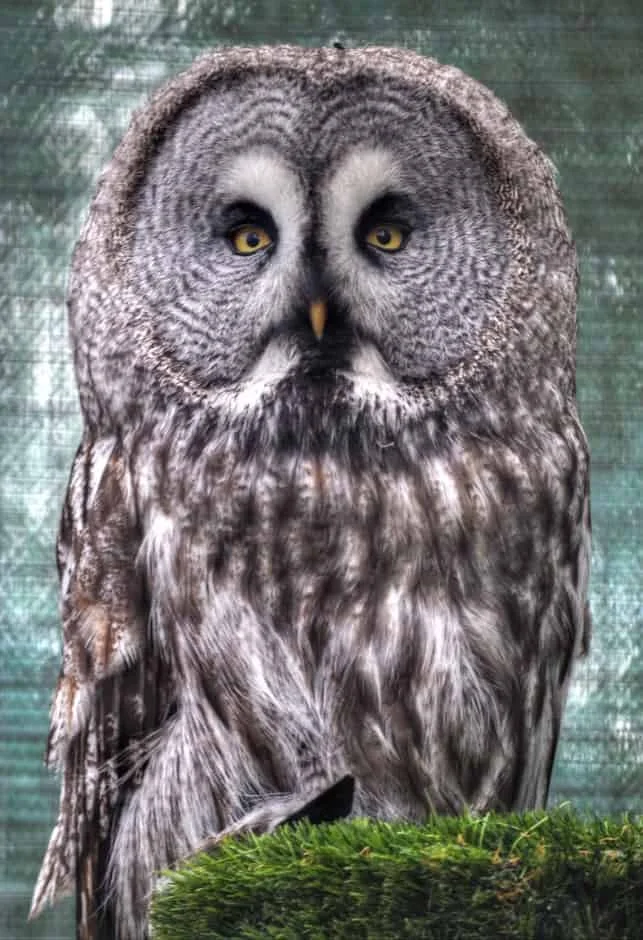
Wingspan
Up to 152cm
Weight
1.1 kg
Life Expectancy
12 years old
Diet
90% small rodents
The Great Gray Owl is an owl that is so large you almost can’t believe it when you see one.
With a startlingly large wingspan that can be up to five full feet, witnessing one of these is enough to humble you when it comes to some of nature’s miracles.
This large owl is known for its unique nesting habits, which involve simply taking over nests left behind from other animals with absolutely no improvements.
Most commonly, the Great Gray Owl will take over nests from ravens and even the odd gray squirrel, happy to move in where other animals have moved out.
Uniquely, they have also been known to lay their eggs on platforms and the broken tops of trees.
The Great Gray Owl is known to spend time sleeping by day and hunting by night.
These nocturnal predators are large enough to spot up in the trees if you are lucky and look closely during the day, but you have a better chance of spotting them when they are more active and moving around at night.
That is when their large wingspan comes out and fills the sky.
These birds are known for staying north, making them more abundant in Michigan than many other places but are generally more active during unusual migrations down south.
The Great Gray Owl is known for spending time in Boreal Forests, which can be found along The Great Lakes across the north.
Michigan is home to many of these forests, making it an ideal place to look for them among the conifer trees.
Unfortunately, these birds are known for their elusive behavior despite their large size. You have a better chance of seeing them on a night hike or while camping than anywhere else.
11. Boreal Owl (Very Rare)
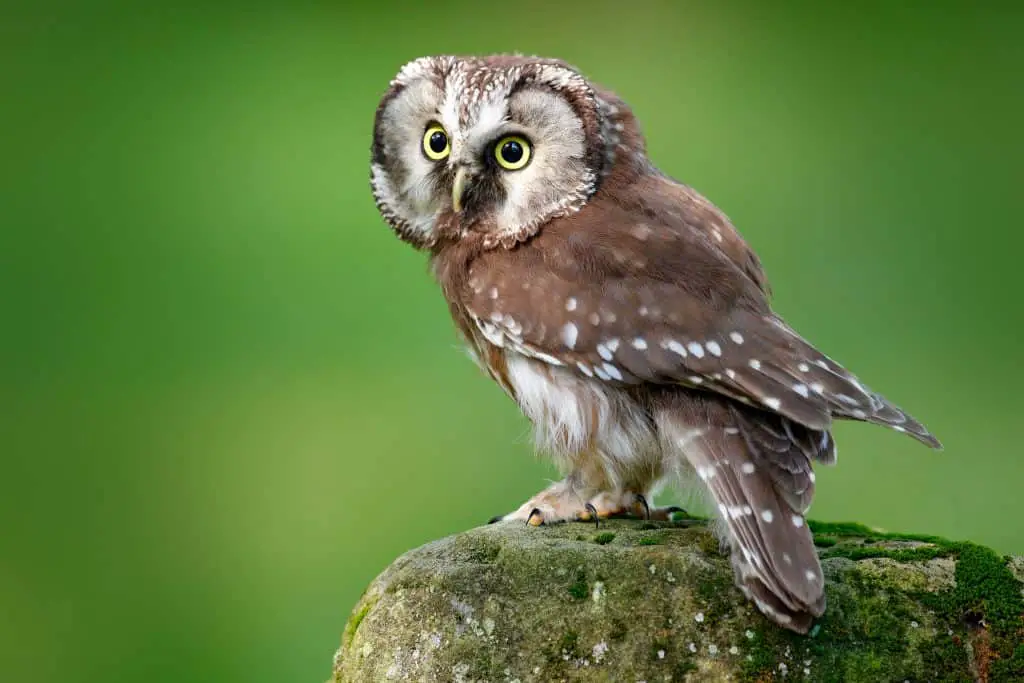
Wingspan
50–62 cm
Weight
120 g
Life Expectancy
16 years
Diet
Small mammals, birds & insects
The Boreal Owl is an adorable little owl known for taking to the skies to hunt small mammals down below.
Many people find that these wonderful owls are a little more wide-eyed than most, with many pictures showing them looking quite a bit startled at having been discovered.
Their nests are sought out by the female owl, who will spend her time looking for the perfect cavity to hide away her precious eggs.
They generally look for convenient cavities that will offer plenty of protection for their eggs, of which there are generally around four in total.
When you are looking for the Boreal Owl, it is generally best to wait for Spring.
Starting in February and for a good couple of months, these little birds stop spending their time tucked away and start venturing out more to find the love of their life.
If you want to see them, you will have to head out at night. These birds are highly nocturnal and enjoy hunting during peak nighttime hours.
During the day, they are difficult to spot because they simply pick a new location as the sun starts to rise, and they are quite small and easy to miss.
The Boreal Owl, true to its name, can be found in Boreal Forests. Fortunately, Michigan is prime territory for this adorable and elusive owl because of the Boreal Forests that it is known to host.
It is just North enough to garner attention from these cute little bundles of feathers.
During the day, you might be able to spot them in a conifer or birch trees, but they will also be well off the ground, generally about twenty feet or so.

More Articles.
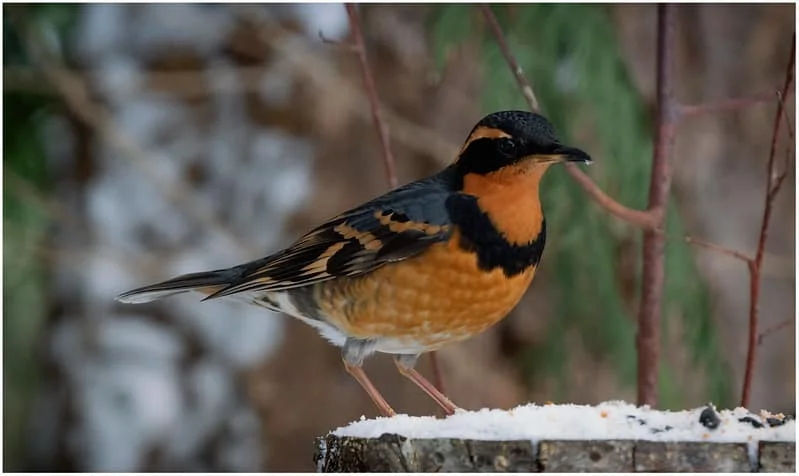
North American Birds with Orange Bellies (15 Species with Sound and Pictures)
North America is filled with many wonderful birds with orange bellies – in fact, there
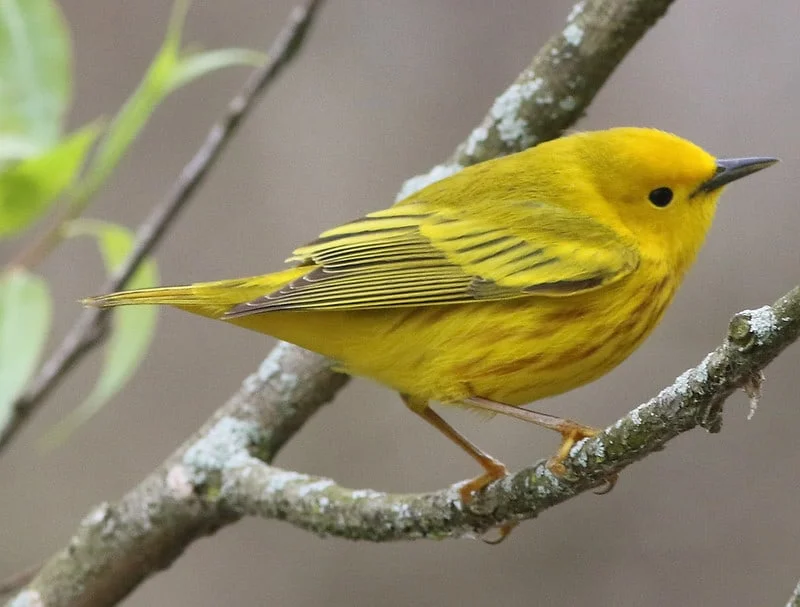
North American Birds with Yellow Wings (12 Species with Pictures and Sounds)
Canada and America are filled with many wonderful birds with yellow wings – in fact,

Can you keep a Hummingbird as a Pet in the US?
In the US, it is in fact illegal to keep hummingbirds as pets in your

About Us
We are avid bird-watchers who recently retired, allowing us more time to travel the world. Fortunately, we have managed to visit numerous countries around Europe, Asia, and America. Watching and photographing birds has been a passion for many years and we are making the most of the extra time on our hands!
